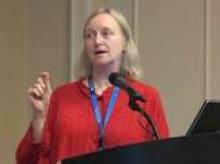Primary care physicians’ assessments of the risks and benefits of cancer screening didn’t match with reality, based on the results of a survey of beliefs and behaviors around cancer risk.
"We were really surprised at the high percentage of physicians who were inaccurately estimating risk," said Dr. Laura-Mae Baldwin, professor of family medicine at the University of Washington, Seattle, who presented on behalf of her colleagues a slice of data from the survey of 3,200 physicians. "This has the potential for average-risk patients to receive unnecessary testing, and for high-risk patients to miss opportunities for prevention or early detection."
The cross-sectional national survey used the 2008 American Medical Association master file to randomly sample family physicians, general internists, and obstetrician-gynecologists. The physicians were all under age 65 and practiced in either a hospital or an office. They were contacted by mail, and given encouragement in the form of a $20 bill. In a second mailing, nonresponders received a written note from Dr. Baldwin. Overall, there was a 62% response rate: 591 family physicians, 414 general internists, and 569 ob.gyns. took part.
Survey participants were given a 12-page booklet with a particular patient vignette and a photo of the patient. The example included a medical and family history, along with age, race, sex, insurance status, and some other characteristics.
The researchers focused on ovarian cancer in particular because the Centers for Disease Control and Prevention, which funded the study, had a special interest in that cancer.
For instance, one vignette presented a 51-year-old white woman who came in because she wanted to be sure she was up to date on various tests. She had no medical problems, but had not seen a physician in 3 years. Her father had hypertension and her mother died of ovarian cancer at age 65. The other family history was negative, and there was an unremarkable physical exam.
The researchers had 258 variations for the different vignettes, varying age, race, insurance status, whether the patient asked for ovarian cancer screening, and family history. Physicians were asked to give their best estimate for this patient, and for other example patients, of risk for breast, ovarian, and colon cancer. They were asked to state whether the patient had a risk that was the same as that of the general population, somewhat higher, or much higher.
For a woman who was at the same risk as the general population for ovarian cancer, 72% of physicians were in agreement. However, 26% estimated the women were at somewhat higher risk and 1%, at much higher risk. For women at somewhat higher risk for ovarian cancer, however, 7% of physicians correctly assessed risk. Risk was assessed as somewhat higher or much higher by 90%, Dr. Baldwin reported at the annual meeting of the North American Primary Care Research Group.
For a woman at high risk for ovarian cancer, 35% of physicians correctly estimated that risk. Most physicians estimated risk as somewhat higher, but 11% thought her risk was the same as that for the general population.
The assessments of risk for colon cancer were similarly inaccurate. For the vignette of the woman at the same risk as the general population, 62% of physicians were on target, and 39% overestimated the risk.
There were no significant differences among the specialties, but ob.gyns. tended to be more accurate in their screening decisions, said Dr. Baldwin. An analysis showed that providers’ personal history with cancer influenced their recommended screening behaviors, said Dr. Baldwin. She did not present specific data on that issue.
The study did have some limitations in that physicians were given somewhat limited information about the patient’s risk. Dr. Baldwin said it’s important to study physician behaviors further, especially since so many in the survey underestimated risk in a woman who clearly was at high risk for ovarian cancer.


